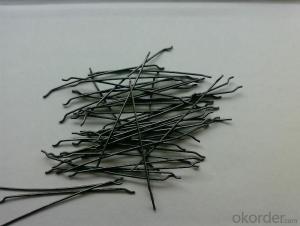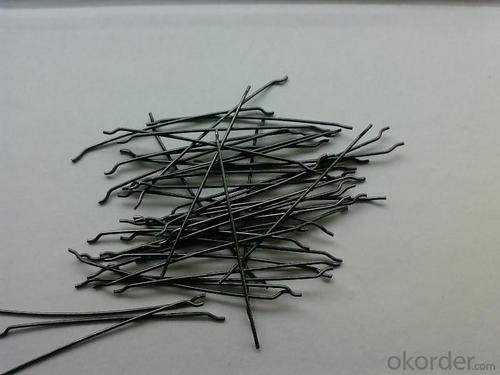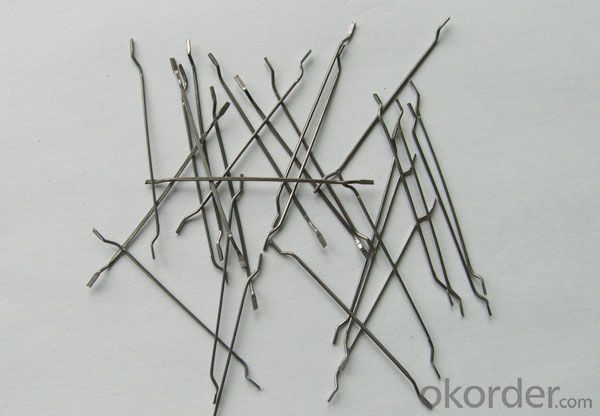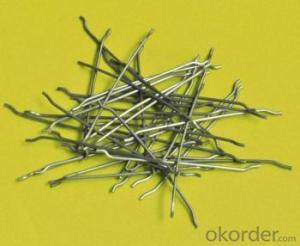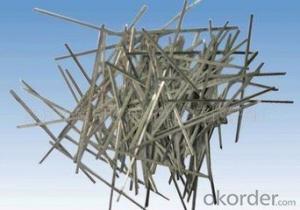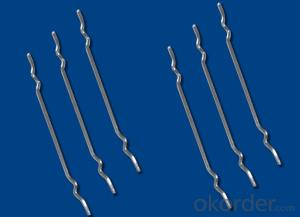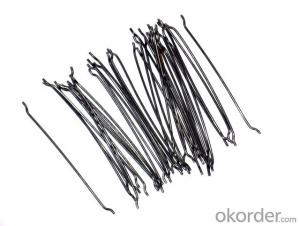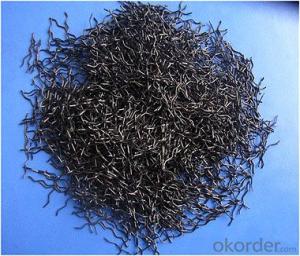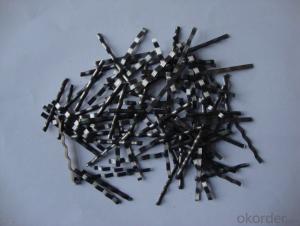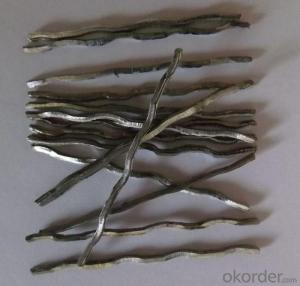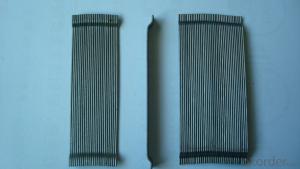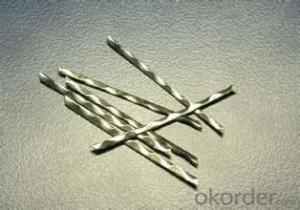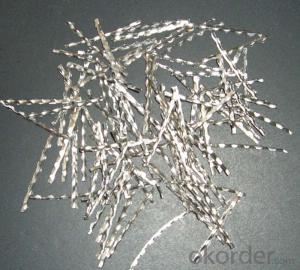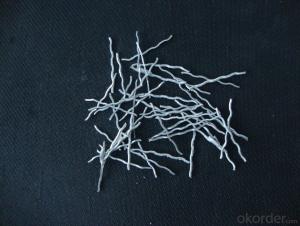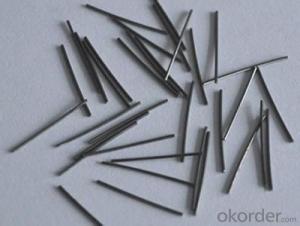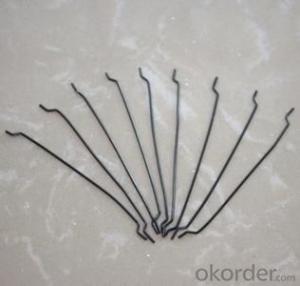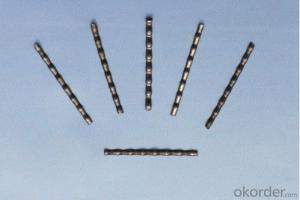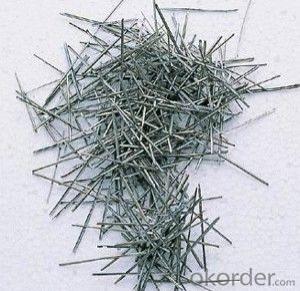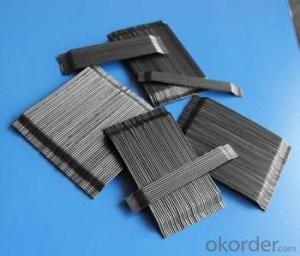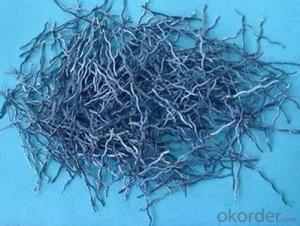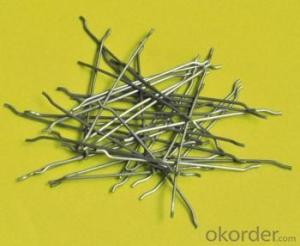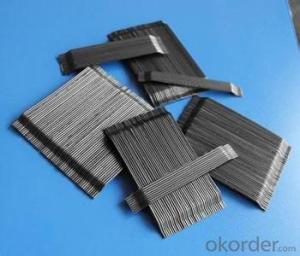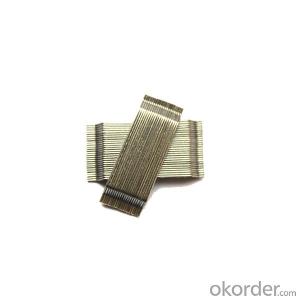Melt Extract Stainless Steel Fiber as Concrete Admixtures CNBM
- Loading Port:
- Tianjin
- Payment Terms:
- TT OR LC
- Min Order Qty:
- 2000 kg
- Supply Capability:
- 250000 kg/month
OKorder Service Pledge
OKorder Financial Service
You Might Also Like
Quick Details
Place of Origin: Shandong, China (Mainland), Shandong, China (Mainland)
material: steel wire
type: wavy steel fiber
shape: corrugated flat fiber
usage: concrete reinforcement
appearance: clear and bright
Product features
steel fiber are for concrete construction, greatly improves concrete bonding and tensile strength .
The steel fiber is made of high-quality low carbon steel wire,with the characteristic of the high tensile strength,good toughness,etcs.This product is widely used in the construction fields for concrete reinforcement
Specifications
| The Specification of Hooker Ends Steel Fiber | ||||
| TYPE | Diameter(mm) | Length(mm) | Length/Diameter | Tensile strength |
| LB-60/60 | 1.0 | 60 | 60 | >=1000Mpa |
| LB-50/50 | 1.0 | 50 | 50 | >=1000Mpa |
| LB-65/60 | 0.9 | 60 | 65 | >=1000Mpa |
| LB-55/50 | 0.9 | 50 | 55 | >=1000Mpa |
| LB-80/60 | 0.75 | 60 | 80 | >=1000Mpa |
| LB-45/35 | 0.75 | 35 | 45 | >=1000Mpa |
| LB-55/30 | 0.55 | 30 | 55 | >=1000Mpa |
| LB-60/30 | 0.5 | 30 | 60 | >=1000Mpa |
| LB-50/25 | 0.5 | 25 | 50 | >=1000Mpa |
| LB-60/25 | 0.4 | 25 | 60 | >=1000Mpa |
Picture

steel fiber for concrete reinforcement
steel fiber are for concrete construction, greatly improves concrete bonding and tensile strength .
The steel fiber is made of high-quality low carbon steel wire,with the characteristic of the high tensile strength,good toughness,etcs.This product is widely used in the construction fields for concrete reinforcement
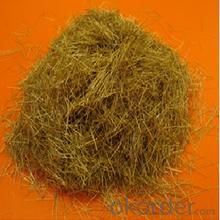
FAQ
we can produce any type steel fiber and of course we can make production according to your requirement
we have specilize in this field for almost 10 years ,with good quality and competitive price
- Q: Does melt extract stainless steel fiber improve the freeze-thaw resistance of concrete?
- Indeed, the incorporation of melt extract stainless steel fiber undoubtedly enhances the freeze-thaw resistance of concrete. By introducing stainless steel fibers into the concrete mixture, the durability and ability of the material to endure the harsh consequences of freeze-thaw cycles are significantly improved. The distinctive attributes of stainless steel, such as its remarkable tensile strength and resistance to corrosion, effectively strengthen the concrete matrix and prevent any cracks or deterioration caused by freeze-thaw cycles. The fibers function as a reinforcement system within the concrete, providing enhanced resistance against the expansion and contraction that occurs due to freezing and thawing. As a result, this ultimately extends the lifespan of concrete structures and diminishes the necessity for expensive repairs or replacements.
- Q: How does melt extract stainless steel fiber impact the early-age cracking of concrete?
- Concrete is prone to cracking in its early stages due to the rapid evaporation of moisture from the surface, causing shrinkage and tension within the material. However, incorporating melt extract stainless steel fibers into the concrete mixture can address this issue. These fibers act as reinforcement, adding strength and stability to the concrete. The stainless steel fibers help distribute the stress load evenly throughout the concrete, preventing the concentration of tension at specific points and reducing the likelihood of cracking. This improves the overall durability of the concrete structure. In addition, the presence of stainless steel fibers improves the microstructure of the concrete. They serve as sites for the formation of hydration products, resulting in a denser and more compact matrix. This densification makes the concrete less permeable, reducing moisture loss and minimizing the potential for early-age cracking. Furthermore, the stainless steel fibers also enhance the behavior of the concrete after cracking. If cracks do occur, the fibers act as bridges, preventing further propagation and safeguarding the structural integrity. This ensures that any cracks that do appear during the early stages will not develop into larger, more significant cracks over time. In conclusion, the inclusion of melt extract stainless steel fibers in concrete significantly reduces the occurrence of early-age cracking. These fibers improve the mechanical properties, distribute stress, enhance the microstructure, and provide bridging effects. As a result, the concrete becomes more durable and resistant to cracking.
- Q: How does melt extract stainless steel fiber improve the resistance of concrete to impact loads?
- Melt extract stainless steel fiber improves the resistance of concrete to impact loads in several ways. Firstly, the addition of stainless steel fibers to concrete significantly enhances its tensile strength and ductility. These fibers act as a reinforcement, distributing the applied load more evenly throughout the concrete matrix and reducing the concentration of stress points. This helps to prevent the formation and propagation of cracks, increasing the overall resistance of the concrete to impact loads. Moreover, the unique properties of stainless steel, such as high strength, corrosion resistance, and durability, contribute to the improved impact resistance of concrete. Stainless steel fibers are extremely tough and can withstand high impact forces without breaking or deforming. This toughness allows them to effectively absorb and dissipate energy during impact, preventing the occurrence of catastrophic failure. Additionally, the small size and high aspect ratio of melt extract stainless steel fibers promote better bonding between the fibers and the concrete matrix. This strong bond ensures that the fibers remain well-anchored within the concrete, even under high impact loads. This, in turn, increases the overall strength and integrity of the concrete, making it more resistant to impact-induced damage. Furthermore, the addition of stainless steel fibers can also enhance the post-cracking behavior of concrete. When cracks do occur due to impact loads, the fibers help to hold the cracked sections together, preventing further separation and limiting the extent of damage. This post-cracking behavior contributes to the overall improvement in the resistance of concrete to impact loads. In summary, melt extract stainless steel fiber improves the resistance of concrete to impact loads by enhancing its tensile strength, ductility, and toughness. The fibers contribute to a more even distribution of applied loads and prevent the formation and propagation of cracks. Their strong bond with the concrete matrix and ability to absorb and dissipate energy during impact further enhance the impact resistance of the concrete.
- Q: Can melt extract stainless steel fiber be used in water treatment plants?
- Yes, melt extract stainless steel fiber can be used in water treatment plants. It is commonly utilized in various processes such as filtration, sedimentation, and sludge dewatering due to its corrosion resistance and high strength properties. The stainless steel fiber helps to improve the efficiency and effectiveness of water treatment processes by enhancing filtration, reducing clogging, and increasing the lifespan of equipment.
- Q: Can melt extract stainless steel fiber be used in retaining walls?
- Retaining walls can indeed utilize melt extract stainless steel fiber. In numerous construction scenarios, including retaining walls, stainless steel fiber serves as a prevalent reinforcement material. It boasts exceptional tensile strength, corrosion resistance, and durability, rendering it ideal for withstanding the pressures and forces confronting retaining walls. By incorporating stainless steel fiber into the concrete mixture, the overall structural integrity of the retaining wall can be enhanced, reducing the likelihood of cracking and enhancing its long-term performance. As a result, melt extract stainless steel fiber presents itself as a fitting choice for reinforcing retaining walls.
- Q: Can melt extract stainless steel fiber be used in high-performance concrete applications?
- Yes, melt extract stainless steel fiber can be used in high-performance concrete applications. Stainless steel fibers are known for their high tensile strength, corrosion resistance, and durability. These properties make them suitable for applications where concrete structures are subjected to high loads, severe weather conditions, or aggressive environments. In high-performance concrete, stainless steel fibers are commonly added to enhance the mechanical properties of the material. The fibers help to improve the concrete's resistance to cracking, increase its flexural and tensile strength, and enhance its resistance to impact and fatigue. This makes high-performance concrete with stainless steel fibers ideal for applications such as bridge decks, industrial floors, tunnels, and other structures that require enhanced durability and strength. Melt extract stainless steel fibers are produced by melting stainless steel and then rapidly extracting it into fibers. This manufacturing process ensures that the fibers have a uniform diameter and high aspect ratio, which further enhances their performance in high-performance concrete applications. The fibers are typically added to the concrete mix in a specific dosage to achieve the desired reinforcement effect. The use of melt extract stainless steel fibers in high-performance concrete has been extensively studied and proven effective. Numerous research studies and field applications have shown that the addition of stainless steel fibers can significantly improve the mechanical properties and durability of high-performance concrete. These fibers can help to reduce cracking, increase the load-bearing capacity, and enhance the overall performance of the concrete structure. However, it is important to note that the dosage of stainless steel fibers and the concrete mix design should be properly evaluated and optimized for each specific application. This will ensure that the desired performance requirements are met without negatively affecting other properties of the concrete mix, such as workability or finishability. In conclusion, melt extract stainless steel fiber can be successfully used in high-performance concrete applications. Its high tensile strength, corrosion resistance, and durability make it an excellent reinforcement material for structures subjected to high loads, severe weather conditions, or aggressive environments. Proper dosage and mix design considerations are crucial to achieve the desired performance while maintaining the overall quality of the concrete.
- Q: Does melt extract stainless steel fiber improve the fire resistance of reinforced concrete columns?
- Yes, melt extract stainless steel fiber does improve the fire resistance of reinforced concrete columns. These fibers enhance the concrete's ability to withstand high temperatures, reducing the risk of structural failure and improving the overall fire performance of the columns.
- Q: How does melt extract stainless steel fiber improve the fire resistance of concrete?
- Melt extract stainless steel fiber improves the fire resistance of concrete by acting as a reinforcement material. When the concrete is exposed to high temperatures during a fire, the stainless steel fiber helps to enhance the structural integrity of the concrete by providing additional strength and stability. The stainless steel fiber is able to withstand high temperatures without melting or losing its mechanical properties. This allows it to effectively distribute the stress and load within the concrete, preventing cracks and fractures that could compromise the structural integrity of the material. Furthermore, the presence of stainless steel fiber in the concrete helps to delay the onset of spalling. Spalling is a phenomenon in which the surface layers of concrete break apart and detach due to the rapid expansion of the moisture trapped within the material when exposed to high temperatures. By reinforcing the concrete, the stainless steel fiber helps to retain the moisture and prevent its rapid release, thereby reducing the risk of spalling. In addition to its reinforcing properties, the stainless steel fiber also acts as a heat sink. This means that it absorbs and dissipates heat more efficiently than the surrounding concrete, which helps to reduce the overall temperature rise of the material during a fire. By reducing the temperature rise, the stainless steel fiber can minimize thermal expansion and contraction, reducing the likelihood of cracks and maintaining the structural integrity of the concrete. Overall, the incorporation of melt extract stainless steel fiber in concrete significantly improves its fire resistance by enhancing its structural strength, reducing spalling, and minimizing temperature rise. This makes it an effective solution for increasing the fire safety of concrete structures in various applications, such as buildings, tunnels, and industrial facilities.
- Q: Can melt extract stainless steel fiber be used in high-strength concrete mixtures?
- Yes, melt extract stainless steel fiber can be used in high-strength concrete mixtures. Stainless steel fibers offer several advantages when added to concrete, including increased tensile strength, crack resistance, and durability. The melt extract process ensures that the fibers have a uniform shape and size, which enhances their performance in the concrete mix. The high-strength concrete mixtures require reinforcement to better withstand heavy loads and reduce the risk of cracking, and stainless steel fibers can effectively fulfill this role. Additionally, the corrosion resistance of stainless steel fibers makes them suitable for use in high-strength concrete mixtures, even in harsh environments. Overall, melt extract stainless steel fibers can enhance the properties of high-strength concrete, making it a reliable and durable material for various construction applications.
- Q: Can melt extract stainless steel fiber be used in asphalt mixtures?
- Yes, melt extract stainless steel fiber can be used in asphalt mixtures. Stainless steel fibers are commonly used in asphalt mixtures to improve the mechanical properties and durability of the pavement. These fibers help to enhance the tensile strength, crack resistance, and fatigue life of the asphalt mixture. They also improve the resistance to rutting and thermal cracking. Additionally, stainless steel fibers can enhance the overall performance and lifespan of the asphalt pavement by reducing maintenance costs and increasing the overall structural integrity of the roadway. Therefore, melt extract stainless steel fibers are a suitable choice for enhancing the performance and durability of asphalt mixtures.
Send your message to us
Melt Extract Stainless Steel Fiber as Concrete Admixtures CNBM
- Loading Port:
- Tianjin
- Payment Terms:
- TT OR LC
- Min Order Qty:
- 2000 kg
- Supply Capability:
- 250000 kg/month
OKorder Service Pledge
OKorder Financial Service
Similar products
Hot products
Hot Searches
Related keywords
